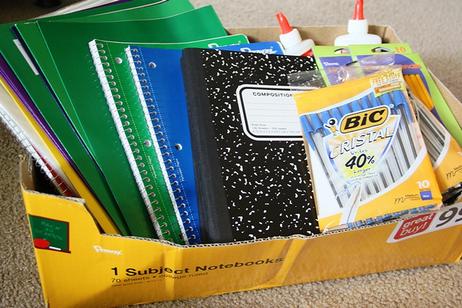It’s back-to-school time, are your kids ready? One of the most stressful parts of back-to-school season is making sure your children get everything they need, without breaking the bank.
Teachers today seem to request more and more supplies than ever before. Whether physical or electronic, it’s a tall task to find and purchase the items at a reasonable cost. We’ve paneled some school, retail, and savings experts to get the best tips and strategies so you can get the best supplies on a smart budget.
Here are 10 expert back-to-school shopping tips.
1. Use supplies from last year
Before you do anything else, check last year’s school supplies to see if they are still in useable condition. Don’t purchase new supplies if the old ones can be made to last a while longer. Lunchboxes, backpacks, clothes, sports equipment, and other school paraphernalia can often make a return appearance. Sometimes, you’ll find unopened packs of pens, pencils, and other items that you may have forgotten about.
2. Make a list – and stick to it
Make a list before leaving the house. According to Dr. Deborah Gilboa, also known as parenting expert “Doctor G,” says a list is vital to staying on budget. “We tend to shop more responsibly when a list is guiding our purchases… [It] helps cut down impulse buying.” Many teachers also hand out supply sheets for their students and it is a good idea to bring this document along on shopping trips so that children get exactly what they need for any particular class.
Tim Sullivan, Founder of TeacherLists.com, says sticking to a teacher’s assigned list is mandatory. “Many teachers color code their classes to help keep track of assignments. If the teacher asks for an orange folder, buy an orange folder. If you buy a green one, chances are you’ll have to buy an orange folder anyway.” If you lose track of a teacher’s list, you may be able to find it online. “Because every school has a different protocol for sending out school supply lists, start your search by going to the National School Supply Lists on TeacherLists.com on your smartphone or tablet and search for your child’s list by zip code.”

3. Lease or share expensive items
Graphing calculators, computers, college texts, and other school supplies can often be rented much cheaper than they can be bought outright. Households with multiple children might also consider having their offspring share expensive school materials in order to mitigate costs. College students who are taking the same classes may likewise opt to share textbooks in order to save extra money.
4. Shop on tax-free weekends
Shopping during tax-free weekends is one good way to help lower the cost of pricey items. When this event is “combined with coupons and discount codes, parents can save big.” reports Marie Nicola, Content Manager and PR Director at SchoolSupplies.com.
Trae Bodge, Senior Lifestyle Editor of RetailMeNot.com, agrees. “If you plan to shop in-store, shop during your local sales tax holiday. Most states typically offer a sales tax holiday sometime in July or August. This is a smart move, especially for bigger purchases, like tech items.”
5. Hunt for coupons and discounts
Dr. Deborah Gilboa suggests getting kids involved on the coupon fun. “Even kindergarteners can cut out coupons and retailers have tons of them available for back-to-school items. Tweens and Teens can challenge each other to see who can save the family most money. They can check online for sales and use discount websites.” By gamifying the experience, kids have fun learning how to save.
“If there is a big ticket item that your student ‘must have’ and you believe it is a reasonable purchase, offer to share the cost. Kids who spend their own money tend to take better care of their belongings and may even reconsider the purchase.”

6. Be savvy about deals
Make sure the deal you are getting is really a deal, and the product you are getting is something you really need. “It's easy to get swept up in the excitement of the crazy sales and deals this time of year and end up buying something you don't really need.” says Karl Quist, President of Priceblink and InvisbleHand.“ Remember, if your kids won’t use it, it’s a waste of money.” agrees Jon Lal, CEO of BeFrugal.com.
7. Shop online
Some of the best deals on school items can be found online, and price comparison tools are helping parents find fast, easy deals. This method of purchasing school supplies can also cut down the frivolous purchases that sometimes result from wandering around the mall. “Do your shopping at sites that offer free shipping with a minimum purchase that you know you can reach.” suggests Trae Bodge of RetailMeNot.com. Jon Lal of BeFrugal.com says you can also avoid distractions with online shopping. “When you skip the mall, you also get to avoid the kids dragging you into stores and down aisles, resulting in buying a lot of things you don't need.”
Try PriceBlink for price comparisons, a browser add-on that automatically finds lower prices while you shop. The app provides instant, automatic price comparisons across the internet. BeFrugal.com is another go-to site that lets you earn cash back on purchases while you shop across 4000+ online stores. Looking for coupons? Try RetailMeNot’s Back to School Page or Coupons App for some awesome deals.
8. Buy in bulk
Buy school items, such as pencils and notebook paper, in bulk. This technique is most effective for households with multiple students, but single-child families can consider doubling up with others for extra savings on basic supplies. Parents with a lot of books on their shopping lists may also want to check out Scribd, the Netflix for Books, for access to many different types of eBooks at a flat monthly rate. This makes it great for multi-children families and also for parents who want to complete reading assignments with their kids.
Sometimes, a school supply bundle can be the answer. Bundles, like those at SchoolSupplies.com, can be a money saving goldmine. The savings can add up to 20-30% when compared to shopping the same items in store.
9. Go off-brand Trade expensive brand names for off-brand products when possible. As Trae Bodge of RetailMeNot recommends, “unless your child needs to print high quality photographs for school, look into off-brand ink or off-brand paper. The quality is nearly as good as brand name products and the savings can be substantial.”
10. Buy at the right times
Know the right time to buy. Some supplies can be bought right after school starts such as college textbooks, basic clothing items, and dorm furnishings. Other items will need to be purchased early in the season like themed products, popular clothing styles, and embroidered uniforms. Jon Lal offers this bit of advice, “If you can, wait to buy school supplies until after Labor Day; prices will drop severely late in the season.” However, parents will need to keep in mind that some of the trendier supplies may be sold out long before then and plan accordingly.












